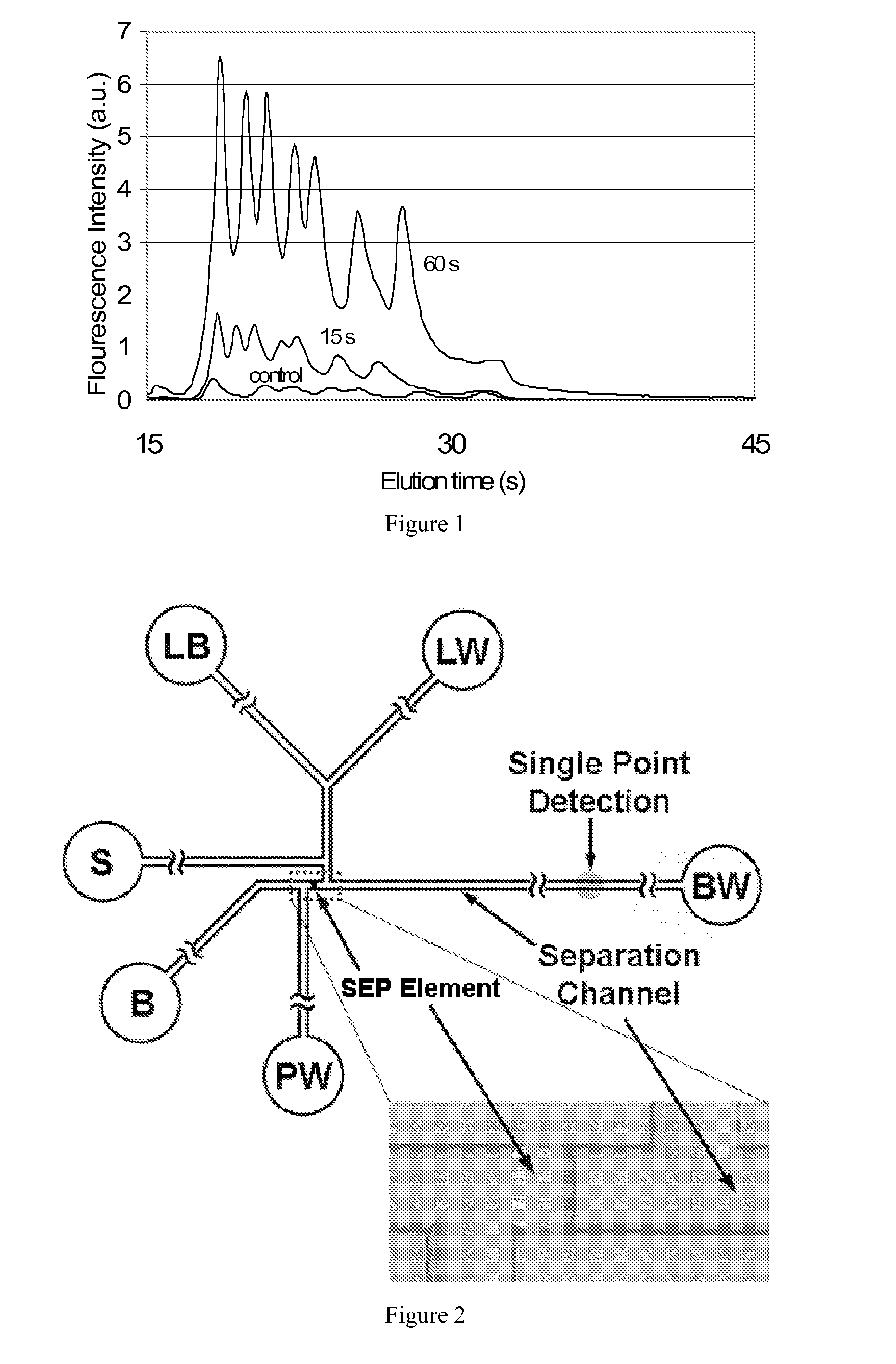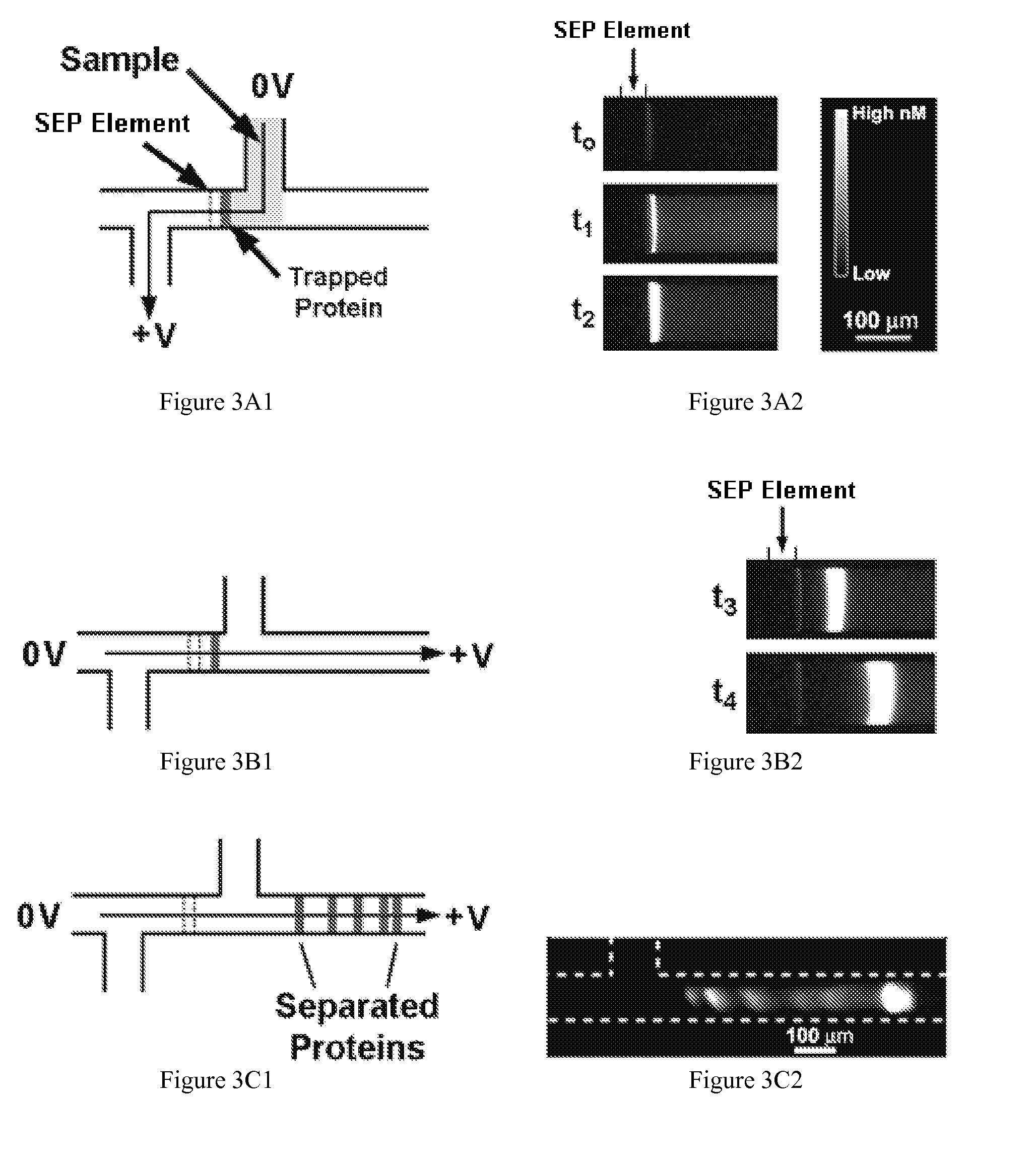Preconcentration and separation of analytes in microchannels
a microchannel and preconcentration technology, applied in the direction of fluid pressure measurement, liquid/fluent solid measurement, peptide measurement, etc., can solve the problems of difficult implementation, difficult to fabricate chips in a reproducible manner, poor optical detection sensitivities, etc., and achieve the effect of increasing the preconcentration resolution
- Summary
- Abstract
- Description
- Claims
- Application Information
AI Technical Summary
Benefits of technology
Problems solved by technology
Method used
Image
Examples
example 1
On-Chip Mixing at the SEP Element
[0200]Mixing of sample with buffer and reagents is a vital component of most integrated microfluidic processes. It is also a challenge for which a number of novel approaches have been employed. Some of the key factors that define the effectiveness of a mixer are the (i) time and (ii) space required for mixing and (iii) the complexity of device fabrication added by the mixing element. Also relevant is whether the mixing depends on the size of the species being mixed or other properties of the sample such as viscosity or pH.
[0201]The processing area adjacent to an SEP element serves as a suitable mixer in terms of device space used for mixing and time required. In the assays tested, proteins from solution 1 can be trapped at the SEP element followed by proteins from solution 2. The components are fully mixed at the SEP element as soon as they are trapped. This could easily be extended to additional solutions. Another advantage is that the ratio of comp...
example 2
Preconcentration Followed by SDS-PAGE of Proteins in a Microchip
[0204]SDS-PAGE is a commonly used protein separation technique for protein size determination and expression profiling. Only more abundant proteins are detectable with standard methods leaving out many important low-abundance proteins from analysis. Using an integrated SEP element and cross-linked PP element for preconcentration and separation of proteins, greater than about a 1,000-fold improvement can be achieved without loss of separation resolution. See Hatch et al. (2006) Anal. Chem. 78(14):4976-4984, which is herein incorporated by reference.
[0205]FIG. 18A shows electropherograms depicting SDS-PAGE of a mixture of proteins. It is evident that without preconcentration, the proteins cannot be detected. As proteins are concentrated prior to separation, the peak height increases. FIG. 18B shows the concentration factor obtained as a function of time of loading. Proteins could be concentrated up to 1400-fold upon 4 min...
example 3
Preconcentration Followed by PAGE of DNA in a Microchip
[0206]Although there are many techniques for amplifying nucleic acid molecules, e.g., PCR, known in the art, there are instances where concentrating the nucleic acid molecules is preferred. Integrated preconcentration and analysis of nucleic acid molecules was achieved using a device and protocol similar to that described in Hatch et al. (2006) Anal. Chem. 78(14):4976-4984, which is herein incorporated by reference. However, as provided herein, the PP element was 8% T 5% C in order to separate smaller nucleic acid molecules. The SEP element dimensions and pore size was as previously described (22% T 6% T). The applied field for preconcentrating nucleic acid molecules was 150 V / cm for times ranging from about 1 to about 8 minutes and the field applied for separation was 300 V / cm. Nucleic acid molecules ranging from about 20 to greater than about 1,000 bp have been effectively preconcentrated and separated using these methods, inc...
PUM
| Property | Measurement | Unit |
|---|---|---|
| Length | aaaaa | aaaaa |
| Length | aaaaa | aaaaa |
| Acidity | aaaaa | aaaaa |
Abstract
Description
Claims
Application Information
 Login to View More
Login to View More - R&D
- Intellectual Property
- Life Sciences
- Materials
- Tech Scout
- Unparalleled Data Quality
- Higher Quality Content
- 60% Fewer Hallucinations
Browse by: Latest US Patents, China's latest patents, Technical Efficacy Thesaurus, Application Domain, Technology Topic, Popular Technical Reports.
© 2025 PatSnap. All rights reserved.Legal|Privacy policy|Modern Slavery Act Transparency Statement|Sitemap|About US| Contact US: help@patsnap.com



